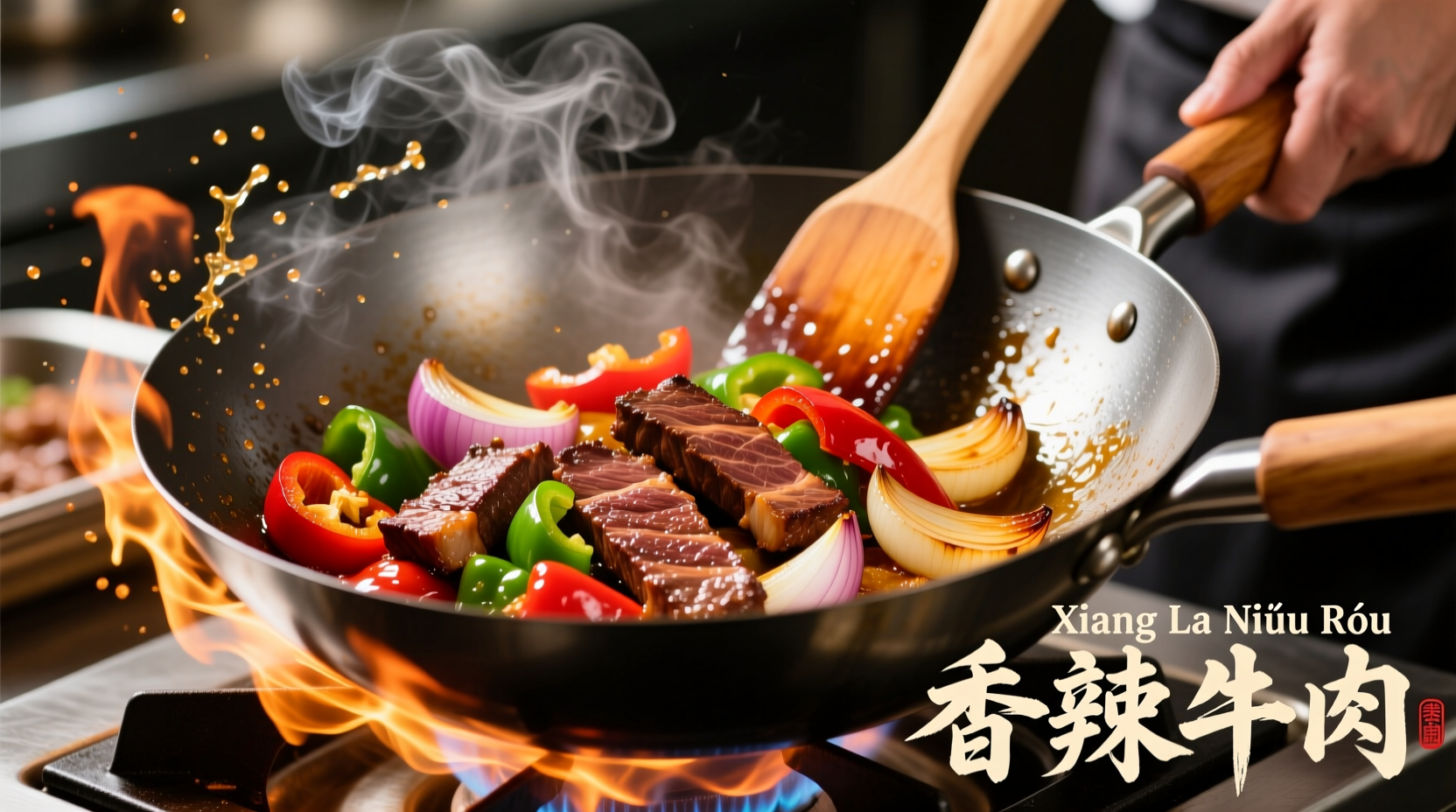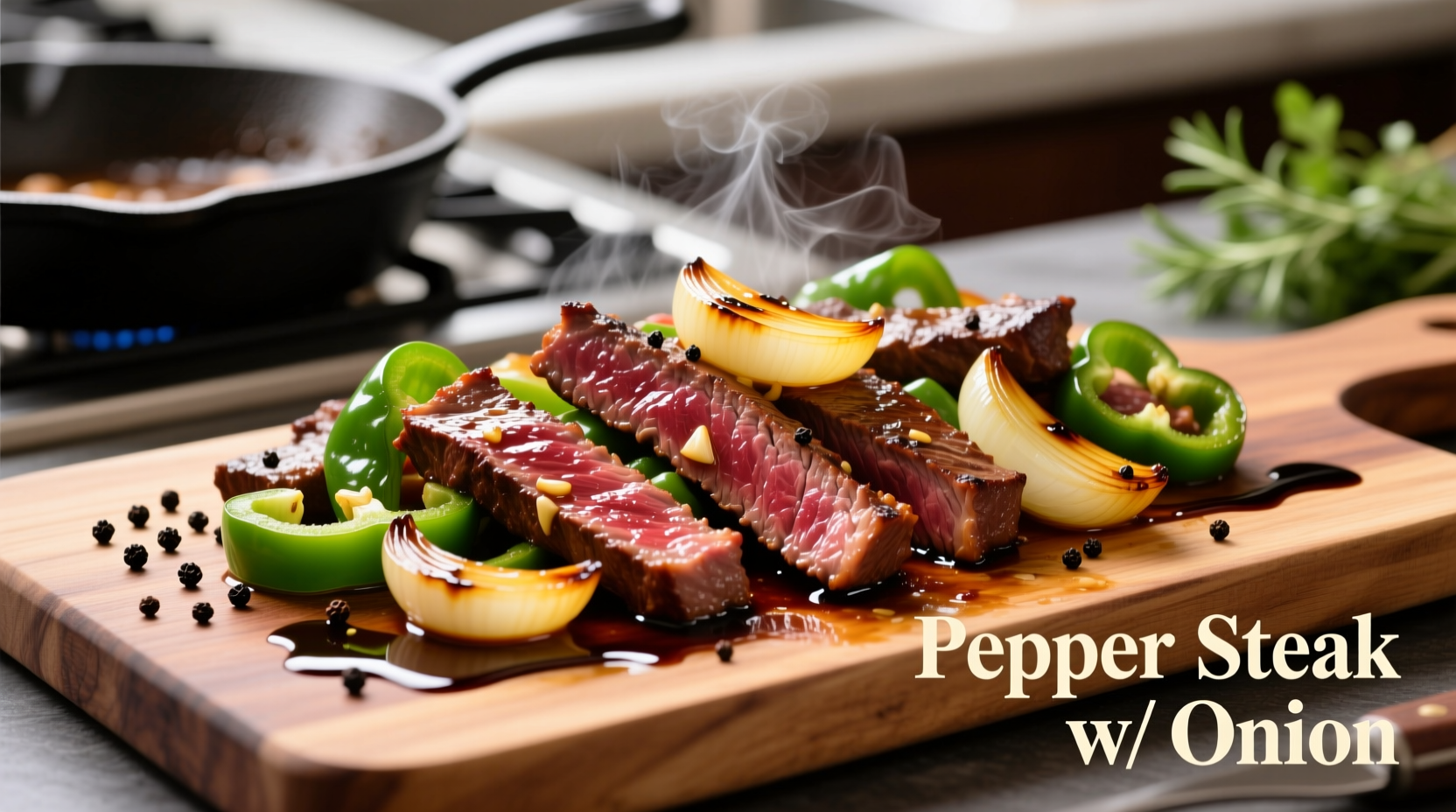Pepper steak with onions is a classic American-Chinese dish featuring tender strips of beef stir-fried with bell peppers and onions in a savory sauce. The perfect recipe uses flank steak, sliced against the grain, stir-fried for 3-4 minutes with crisp-tender vegetables and a glossy sauce made from soy sauce, oyster sauce, and a touch of sugar. This 30-minute meal serves 4 and delivers restaurant-quality results with proper technique.
Your Complete Guide to Perfect Pepper Steak with Onions
Nothing beats the sizzle of a hot wok creating that signature restaurant-style pepper steak with onions. As a chef who's mastered this dish across countless kitchen shifts, I've discovered the precise techniques that transform simple ingredients into a meal that rivals your favorite Chinese takeout—without the delivery fee. This guide reveals the professional secrets for achieving tender beef, crisp vegetables, and that perfect glossy sauce every time.
Why This Recipe Works
The magic of pepper steak with onions lies in three critical elements: proper meat preparation, precise cooking sequence, and balanced sauce chemistry. Unlike many home attempts that result in tough beef or soggy vegetables, this method follows professional stir-fry principles that ensure restaurant-quality results.
| Ingredient | Key Function | Professional Tip |
|---|---|---|
| Flank steak (1.5 lbs) | Lean cut with rich beef flavor | Slice against grain at 45° angle for maximum tenderness |
| Dark soy sauce (2 tbsp) | Creates rich color without oversalting | Always combine with light soy for balanced flavor |
| Cornstarch (1.5 tbsp) | Velvets meat and thickens sauce | Mix with cold water before adding to hot liquid |
| Ginger (1" piece) | Neutralizes meat odors, adds brightness | Julienne for visual appeal and even flavor distribution |
The Evolution of Pepper Steak in American Cuisine
Pepper steak with onions represents a fascinating adaptation of Chinese cooking techniques to American tastes. While authentic Chinese cuisine rarely features bell peppers in stir-fries, this dish emerged from the creative fusion happening in American-Chinese restaurants during the mid-20th century.
1940s-1950s: Chinese immigrants adapted traditional stir-fry techniques using available American ingredients like bell peppers and flank steak
1960s-1970s: Pepper steak became a staple on American-Chinese menus, often featuring thicker sauces to appeal to Western palates
1980s-1990s: Health-conscious adaptations emerged with reduced sodium and increased vegetable content
2000s-Present: Chefs rediscover authentic techniques while maintaining the dish's American identity, focusing on proper meat preparation and sauce balance
Essential Equipment Checklist
While you can make pepper steak in a standard skillet, these tools make a significant difference:
- Carbon steel wok (14" diameter) - Heats quickly and evenly for proper stir-fry technique
- Wok spatula with curved edge - Perfect for tossing ingredients without damaging the wok
- Sharp chef's knife (8") - Essential for proper meat slicing against the grain
- Mandoline slicer (optional but recommended) - Ensures uniform vegetable thickness
Step-by-Step Cooking Process
1. Meat Preparation (Critical Step)
Place flank steak in freezer for 20 minutes to firm up. Slice against the grain at a 45-degree angle into ¼-inch thick strips. Combine with 1 tbsp soy sauce, 1 tbsp Shaoxing wine, and 1 tsp cornstarch. Massage gently for 1 minute, then refrigerate for 15 minutes.
2. Sauce Assembly
Whisk together 3 tbsp light soy sauce, 1 tbsp dark soy sauce, 2 tbsp oyster sauce, 1 tbsp rice vinegar, 1 tbsp brown sugar, and ½ cup beef broth. Set aside.
3. Vegetable Prep
Cut 1 large yellow onion into ¼-inch wedges. Slice 2 bell peppers (1 red, 1 green) into ¼-inch strips. Mince 3 garlic cloves and julienne 1" piece of ginger.
4. The Stir-Fry Sequence
- Heat wok over high heat until smoking (about 2 minutes)
- Add 2 tbsp peanut oil and swirl to coat
- Quick-sear beef in single layer (don't crowd!) for 90 seconds per side
- Remove beef immediately (it will finish cooking later)
- Add 1 tbsp oil, then garlic and ginger for 15 seconds until fragrant
- Add onions and peppers, stir-fry 2-3 minutes until crisp-tender
- Return beef to wok, pour sauce around edges
- Stir constantly until sauce thickens (about 45 seconds)

Common Mistakes to Avoid
Most home cooks make these critical errors that ruin pepper steak:
- Slicing with the grain - Creates tough, chewy meat regardless of cooking time
- Overcrowding the wok - Causes steaming instead of searing (cook in batches)
- Adding cornstarch directly - Creates lumpy sauce (always mix with cold liquid first)
- Using pre-sliced "stir-fry" beef - Often cut incorrectly and treated with tenderizers
When This Recipe Works Best (And When It Doesn't)
Understanding the context boundaries for this pepper steak recipe ensures perfect results:
- Ideal for: Weeknight dinners, meal prep (sauce separate), entertaining with minimal last-minute work
- Not suitable for: Slow cooker adaptations, vegetarian versions (fundamentally a meat dish), gluten-free without proper substitutions
- Temperature sensitivity: Requires high-heat cooking (minimum 400°F) - won't work in standard ovens
- Ingredient flexibility: Bell peppers can be substituted with mushrooms, but onions are essential for authentic flavor
Serving and Storage Tips
Serve immediately over steamed jasmine rice with chopsticks for authentic presentation. For leftovers, store components separately: meat and vegetables in one container, sauce in another, and rice in a third. Reheat in a hot wok with 1 tsp water to restore texture—microwaving will make the beef tough and vegetables soggy.
Popular Variations
- Szechuan style: Add 1 tbsp chili garlic sauce and ½ tsp Szechuan peppercorns
- Honey pepper steak: Replace brown sugar with 2 tbsp honey for sweeter profile
- Low-sodium version: Use reduced-sodium soy sauce and double oyster sauce quantity
- Extra vegetable: Add 1 cup sliced water chestnuts during final stir-fry
Frequently Asked Questions
What's the best cut of beef for pepper steak with onions?
Flank steak provides the ideal balance of flavor and tenderness when properly sliced against the grain. For premium results, use skirt steak or hanger steak, which have richer marbling. Avoid chuck or round cuts, which become tough when stir-fried.
How can I prevent my pepper steak from becoming tough?
Slice against the grain at a 45-degree angle, marinate with cornstarch, and never cook beyond medium-rare. The critical mistake is overcrowding the wok—cook in batches if necessary. Remove beef immediately after searing, as residual heat will continue cooking it when returned to the wok.
Can I make pepper steak with onions ahead of time?
Prepare components separately: slice and marinate beef (up to 24 hours), cut vegetables (up to 12 hours), and make sauce (up to 3 days). Store each in separate containers. Never fully cook ahead—stir-fry takes just 8 minutes, so complete this step right before serving for best texture.
Why does my sauce become watery when I add cornstarch?
This happens when cornstarch isn't properly tempered. Always mix cornstarch with cold liquid (1:1 ratio) before adding to hot sauce. Pour the mixture around the edge of the wok where it's hottest, then stir constantly for 45 seconds until thickened. Adding dry cornstarch directly causes clumping.











 浙公网安备
33010002000092号
浙公网安备
33010002000092号 浙B2-20120091-4
浙B2-20120091-4